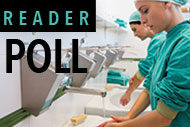Every year, we take a look at a larger health care trend and drill down to what it means for facility professionals. Last year, we focused on new efficiencies evolving from the fast-moving world of technology. This year, we decided to take a step back from virtual reality and focus on the patient with our special report "The front lines of patient safety."
Much of the dialogue around patient safety measures has been directed toward clinical roles — avoiding medical errors, improving antibiotic prescription practices, increasing proper hand hygiene and reducing readmissions. All of these measures are directed squarely at hitting health care's Triple Aim, but they only tell part of the story when it comes to patient safety.
The built environment — how it's constructed, cleaned, maintained and how it functions — also plays a part in patient safety. In our 2015 Salary Survey, for instance, 55 percent of health facility managers reported that their incentive compensation was tied to improvement initiatives and outcomes. Of that 55 percent, 53 percent cited quality-of-care-measures as one of those performance incentives. Other patient-centered incentives include the rate of health care-associated infections (25 percent), patient safety planning (21 percent) and even readmission rates (17 percent).
The focus on patient safety among facility professionals was apparent in our 2015 Sustainable Operations Survey as well. When asked why their health care facilities opted for environmentally sustainable operations, 74 percent of respondents cited patient care quality initiatives as a top reason.
Although, we chose patient safety as our 2015 trend, the focus on how to improve care through innovative and previously untapped resources will continue well into 2016 and beyond. Get an in-depth look at how health facility managers, construction professionals, engineers, environmental services leaders and supply chain directors are helping health care to push the needle further.





